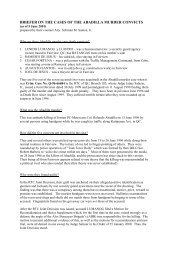Republic of the Philippines - Campaign
Republic of the Philippines - Campaign
Republic of the Philippines - Campaign
Create successful ePaper yourself
Turn your PDF publications into a flip-book with our unique Google optimized e-Paper software.
APPELLANTS’ BRIEF<br />
People <strong>of</strong> <strong>the</strong> <strong>Philippines</strong> vs. Fortuna, et. al.<br />
S. C. G. R. No. 141660-64<br />
vs.Gavarra (155 SCRA 327), People vs. Atencio (156 SCRA 242), and People vs. Intino<br />
(L-69934, September 26, 1988).<br />
It is true that, later on, <strong>the</strong> Supreme Court in People vs. Munoz (G.R. No. L-<br />
38969-70, February 9, 1989) said: “A reading <strong>of</strong> Section 19(1) <strong>of</strong> Article III will readily<br />
show that <strong>the</strong>re is really nothing <strong>the</strong>rein which expressly declares <strong>the</strong> abolition <strong>of</strong> <strong>the</strong><br />
death penalty.” No express abolition, or use <strong>of</strong> <strong>the</strong> word “abolition,” but abolition<br />
none<strong>the</strong>less, as recognized in <strong>the</strong> aforecited Supreme Court decisions. In Munoz, to <strong>the</strong><br />
word “abolition,” <strong>the</strong> Supreme Court preferred to use words like “not impose” and<br />
“prohibition” in characterizing constitutional attitude toward <strong>the</strong> death penalty. 2<br />
The use <strong>of</strong> <strong>the</strong> word “reduced” ra<strong>the</strong>r than “commuted” in Section 19(1) reveals<br />
that <strong>the</strong> operative reality is that <strong>the</strong> death penalty no longer exists. More so when one co-<br />
relates Section 19(1) with Section 13 <strong>of</strong> Art. III: “All persons, except those charged with<br />
<strong>of</strong>fenses punishable by reclusion perpetua when evidence <strong>of</strong> guilt is strong, shall, before<br />
conviction, be bailable by sufficient sureties…” Indeed, in giving an exception to <strong>the</strong><br />
right to bail, <strong>the</strong>re is no mention in <strong>the</strong> Constitution <strong>of</strong> <strong>of</strong>fenses punishable by death..<br />
Recognizing reclusion perpetua as <strong>the</strong> highest penalty instead <strong>of</strong> death reveals an<br />
unmistakable intention to abolish <strong>the</strong> death penalty. Provisions <strong>of</strong> law should be<br />
construed or read, in relation to o<strong>the</strong>r provisions <strong>of</strong> <strong>the</strong> same law (Jueco vs. Flores, G.R.<br />
No. L-19325, February 28, 1964, affirmed in later cases).<br />
This rule <strong>of</strong> statutory, and constitutional, construction finds important application<br />
in this discussion <strong>of</strong> <strong>the</strong> constitutionality <strong>of</strong> <strong>the</strong> death penalty. The constitutional<br />
discussions in <strong>the</strong> majority opinions in <strong>the</strong> Echegaray cases were largely limited to or<br />
framed by Sec. 19(1) itself, particularly <strong>the</strong> issues <strong>of</strong> “cruel, degrading or inhuman<br />
punishment” and <strong>of</strong> “compelling reasons involving heinous crimes.” We will not revisit<br />
2 This and some o<strong>the</strong>r arguments in this discussion are drawn from <strong>the</strong> Free Legal Assistance Group<br />
(FLAG) Position Paper on <strong>the</strong> Death Penalty submitted to <strong>the</strong> Senate Committee on Justice and Human<br />
Rights in July 2002 by its Secretary General Maria Socorro I. Diokno.<br />
Page 22 <strong>of</strong> 127<br />
22




